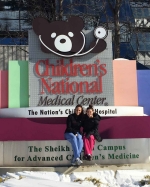Kimberly Gerland, ’13 BSN, RN, CPN, CCRN

Staff RN, Critical Care Float Pool
Children’s National Medical Center, Washington, D.C.
April 18, 2020
From a Facebook post, shared with permission. Kimberly has since been informed that, while too early to say for sure, the patient who received her plasma is showing signs of improvement. On April 22 she was interviewed by the Fox5 TV station in Washington DC to share her story.
I am a second-generation Villanova nurse (mom is Agnes Gerland ’81 BSN) and a third generation Villanova alum. My story is different than many of my fellow classmates and a bit more hopeful.
To close out yet another week in the battle against COVID-19, I want to share a story that will hopefully inspire others. On March 26, I had a positive COVID-19 test after a known exposure. Fortunately, I had relatively mild symptoms and a quick recovery. Two weeks later I was asymptomatic and in order to return back to work I had to test negative. On April 8, I tested negative and was cleared to return to work. I am so fortunate that I work at an institution that has rapid testing capabilities and was able to tell me my results almost instantly.
This past week was an exciting one for me. On Monday, I had reached out to and spoken with a physician at the hospital about convalescent plasma donation and on Wednesday I went to the hospital to donate plasma for the first time. For those who don’t know, plasma donation is a little different than the typical blood donation. They use a pheresis machine which removes whole blood, separates plasma from the red blood cells and then returns the RBCs while collecting the plasma. The process can take anywhere from 1-2 hours. I’m sure many of you know this from the news, but in the fight against COVID-19, hospitals are taking plasma from those who are better and giving it to those badly affected by the virus. The hope is that the plasma of the recovered person contains antibodies that can kill the virus in those who are fighting for their lives.
Because antibody testing is still limited across the country, there is no way of knowing for sure if I have them, but the hope is that I do and that my antibodies can help someone who isn’t as lucky me in their battle against COVID-19. Even if I don’t have the antibodies they want, I know my donation will still go toward saving a life. Times are difficult for everyone, especially my fellow health care workers, but I am excited that I get to help (hopefully) be a part of the cure.
Medicine, science, and the human body are so fascinating when you think about all of this and how far we have come in this fight. I feel blessed to have been eligible to donate and wouldn’t think twice about doing this all over again knowing that this would the ending to my COVID-19 story.
So here is my PSA and really the point of this post: If you have tested positive and you’re fortunate enough to be feeling better please reach out to your local blood bank or The American Red Cross about plasma (or even blood) donation. They will guide you in the process and help determine your eligibility. You can donate plasma every 28 days and blood every 56. Please help in anyway you can to end this battle!
